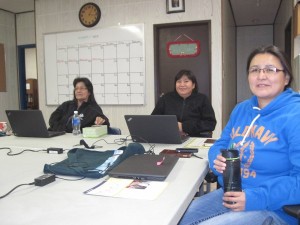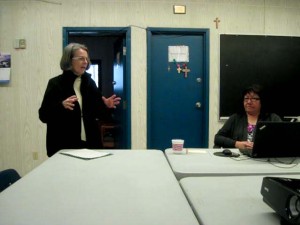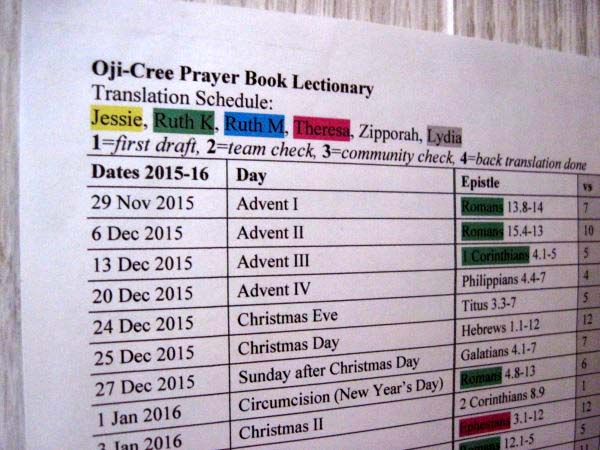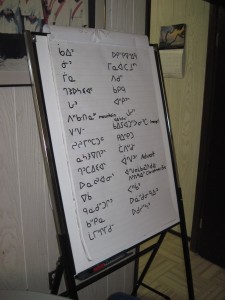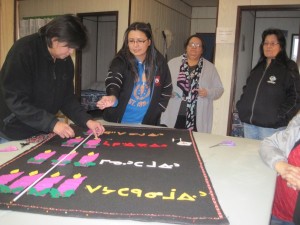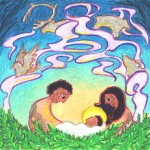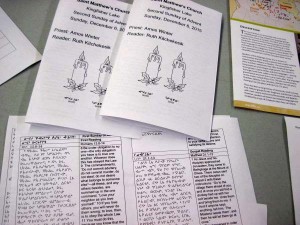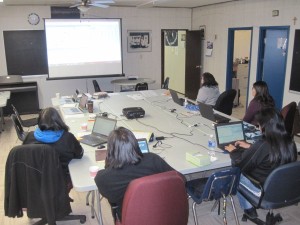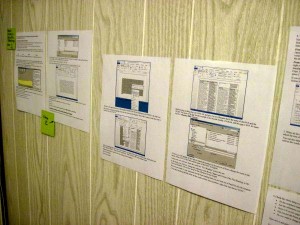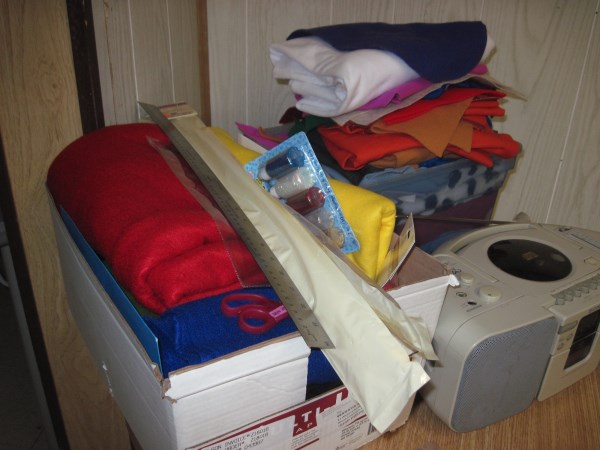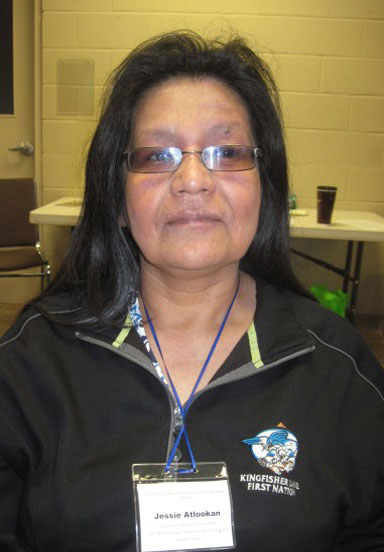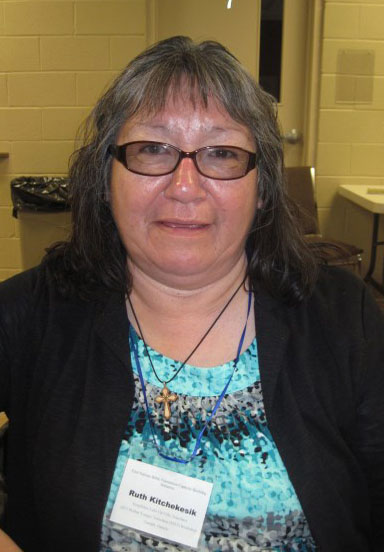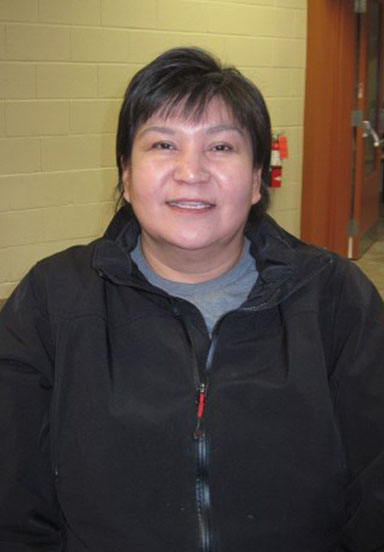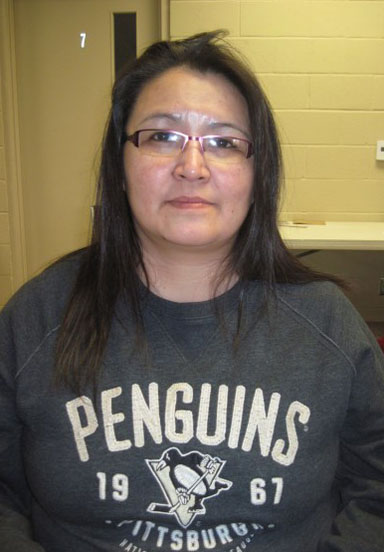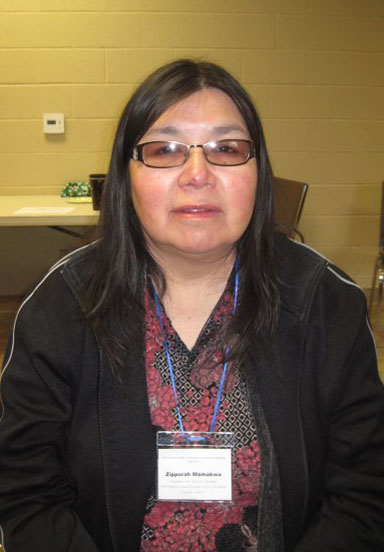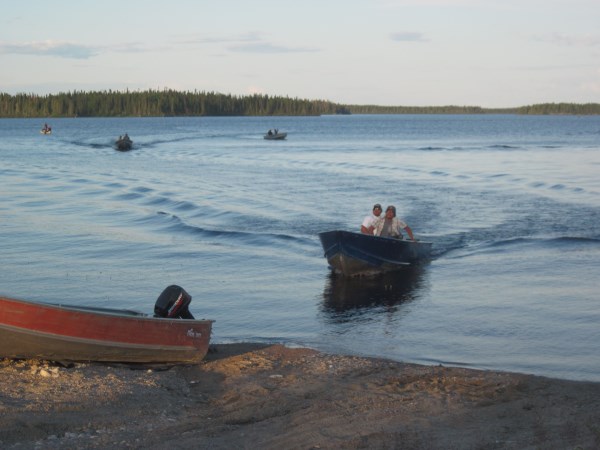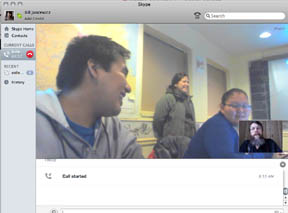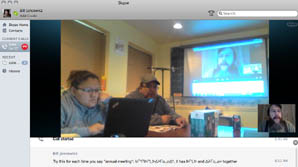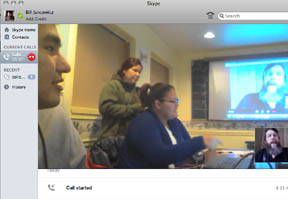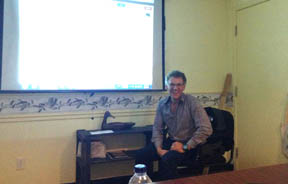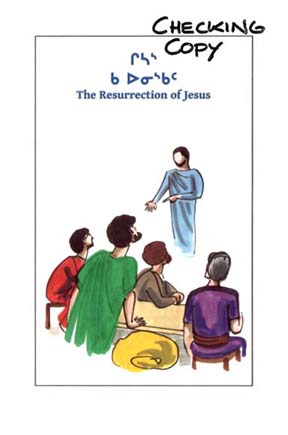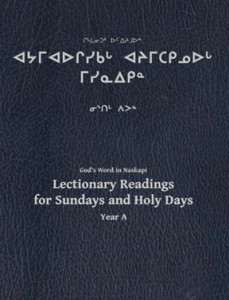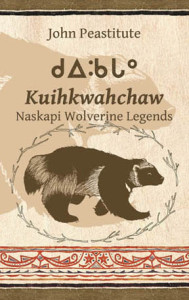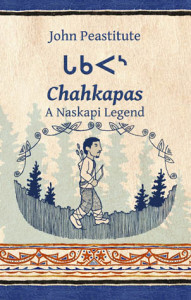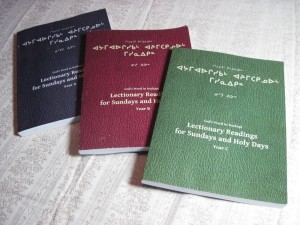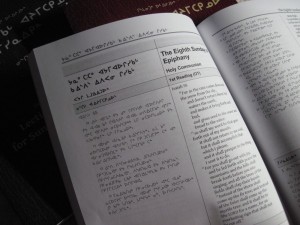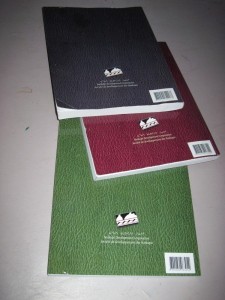Our Dear Partners,
November 2015 on-site workshop at Kingfisher Lake
At the end of October, 2015, we spoke with Bishop Lydia Mamakwa at her diocesan office in the Indigenous Spiritual Ministry of Mishamikoweesh (Anglican Diocese in Northern Ontario) to plan on another visit to help her team prepare the first set of church Scripture readings for Advent 2015.
She asked if we might come the first week of November, so we made plans to do so.
We traveled to Kingfisher Lake from our home on Monday and Tuesday, November 2 & 3. We were accompanied by Wyclffe Canada representative Terri Scruggs, from Calgary. We were all delayed by almost one day because of weather, but were finally able to arrive late Tuesday night.
The workshops begin
On Wednesday, all five translators were available to work with us all day, starting their session at 9:00 AM. The translation team discussed their daily schedule, and since some of the translators have other duties to perform each day, they decided that they would meet each afternoon for a workshop session right after lunch, and work together until suppertime. They also agreed to meet together on Saturday afternoon as well. We worked with translators on an individual basis every morning.
Encouragement from partner organizations
Terri Scruggs, the Wycliffe Canada project administrator, brought greetings from the Wycliffe Canada office in Calgary where she works, and reminded the Oji-Cree translation team that Wycliffe Canada is available to assist and support the project with prayer and church contacts. She shared how happy they were with the progress that the translation team has already made, and described to the team how other Christians in churches across Canada who have heard about it are excited about the Oji-Cree Bible Translation project, and interested in praying for and connecting with the Oji-Cree translation team.
She described a Wycliffe Canada initiative called “Kingdom Friendships” that they facilitate between Canadian churches and organizations like the Indigenous Spiritual Ministry of Mishamikoweesh that are involved in Mother-Tongue Bible translation. She also encouraged the translation team to share how the translated scriptures are having an impact in their own lives and in the lives of the other people who read them.
Daily training schedule
Each day we began the workshop day with a hymn from the Cree hymnal, prayed together for the project, and shared a devotional Bible reading that focused on the Bible text that the team had worked for that day. Next we covered a refresher lesson about basic translation principles that we introduced at the Guelph Mother Tongue Translator (MTT) workshop in April (click here to see this story). Bill also helped the translators to move the project from the “First Draft” (step 1) stage through the other checking and review stages that a Bible translation requires, spending time every day working through the procedures for the other stages.
Other topics covered were how to be sure they knew the meaning of the text before attempting to translate it, how every culture has an effect on the presentation of the meaning of the message, including those cultures that the Bible was originally written to. They also did some brief video studies of the culture and geography of the Bible lands in Jesus’ time, and constantly referred to the print and online resources available that can help the translators to understand the culture and the times.
During the “Team Checking” time each day, the translators discussed the selection and spelling of words that would come up often in their translation work, and, as a group, settled on using certain words and their spelling for consistency. These were written on a flip chart by the team members, and then typed into a computer file with their meanings in English, and kept on a shared computer folder so that they could add to the list of words in the weeks and months to come and refer to it during their drafting and checking sessions.
Scripture engagement – God’s Word in Oji-Cree for the church and community
Because of the importance of connecting the rest of the Oji-Cree community with the work of the translation team, Norma Jean prepared materials to make church banners that not only celebrated the Advent season in artistic symbols, but also include Oji-Cree language scripture and scripture portions. This will help the church and community at large to connect with the translation work that the team is doing into Oji-Cree.
The entire team participated in the hands-on activity of making designs, choosing scripture verses, preparing the syllabic lettering and assembling the banners. These banners are being displayed at Mission House and at St. Matthew’s Church during the season of Advent and Christmas. All of the spare materials and tools for making these scripture engagement banners was left at Mission House after the workshop was over so that the translation team can continue to make their own.
We also described some of the Bible-based children’s books that they had produced in Naskapi, especially the full colour “Jesus is Born” Christmas story in Naskapi. They showed the translators how they could easily replace the Naskapi language text in the computer files for these books and then produce Oji-Cree versions of these books for use in the community. Translation team member Zipporah Mamakwa has already completed the draft of the Oji-Cree text for this project and we expect to have books ready for Christmas.
Another scripture engagement project that was started at Bishop Lydia’s request in the summer is the Book of Alternative Services in Oji-Cree. This started out as a rough translation of pages from the Anglican Book of Alternative Services, with a hand-written version on facing pages in Oji-Cree syllabics, produced “in-house” on a photocopier. We took these materials to start from and produced a professionally-printed prototype (checking copy) of the Book of Alternative Services, Holy Eucharist in Oji-Cree. 

 Five of these checking copies were left with the translation team and Bishop Lydia, who will review and revise the books so that a final publication can be made for use in the church and community.
Five of these checking copies were left with the translation team and Bishop Lydia, who will review and revise the books so that a final publication can be made for use in the church and community.
Fellowship and relationships
A “Gospel Jamboree” was also taking place in Kingfisher Lake the same weekend of the translators workshop. We were privileged to attend three sessions of the Jamboree, and we ourselves sang together once in Naskapi (In the Sweet Bye and Bye) and Bill also sang another time in Cree (Jesus paid it all). 

 They enjoyed being part of this cultural and spiritual celebration, and it was especially good to hear many young people in the community singing Gospel songs in Cree or Ojibwe. We were encouraged and hope that this trend will continue, and that more and more people in the community become engaged in the language development work, and begin to create some of their own songs in Oji-Cree.
They enjoyed being part of this cultural and spiritual celebration, and it was especially good to hear many young people in the community singing Gospel songs in Cree or Ojibwe. We were encouraged and hope that this trend will continue, and that more and more people in the community become engaged in the language development work, and begin to create some of their own songs in Oji-Cree.
We also participated in the first annual Remembrance Day ceremonies that were conducted by the Kingfisher Lake First Nation Canadian Rangers patrol on November 11.


 Current translation progress
Current translation progress
Since the translation team began translating their first few Bible verses themselves into Oji-Cree on 23 April 2015 at the Guelph Mother Tongue Translator (MTT) workshop, the team has made steady progress. As of the end of this workshop they have translated a total of more than 1200 verses in “First Draft” (step 1), moving toward the goal of having all the Sunday readings prepared for St. Matthew’s Church for this coming year.
During the workshop, Bill guided the team through the “Team Check” (step 2) procedure for all the readings for the Advent and Christmas services. This part of the procedure has the entire translation team working together on the same passage, reading through a translation that one of the team members has already completed. This helps the translator to make corrections and adjustments to her translation so that it is more clear, accurate and natural. So by the end of the workshop on November 11th, all the readings were ready for printing out for the Sunday church services through the end of December 2015.
Meeting with Bishop Lydia
Because of family and ministry responsibilities, Bishop Lydia Mamakwa was only in the community on Saturday and Sunday during the workshop weeks. She graciously took time to meet with us late Sunday afternoon before she had to leave for another ministry trip outside the community. During this meeting, we reported to her about the progress of her team and the activities of this workshop.
We covered several topics with the Bishop that concern the new Oji-Cree translation project. They prayed with her for her family and her travels, and reported on the work with the translators during the first four days of the workshops. They discussed some of her goals for the project and did some planning about when we might come back to Kingfisher Lake again.
The Bishop said that she would be pleased to have the Oji-Cree Bible Translation team be part of Wycliffe Canada church connections and have the Oji-Cree team, committee and project remembered and prayed for regularly.
We grateful that the Bishop took the time to meet and pray with us, and feel that God is at work in her and in the Oji-Cree Translation project.
Continuing work after the workshop
The translation team reviewed the next steps that they will need to take over the coming months to stay on schedule with the translation goals that their committee has set.
They will continue to translate the “First Draft” (step 1) of the Epistle and Gospel for the Sunday readings according to the schedule in their Bible Translation office. They were also encouraged to meet together as a team at least once per week, in order to accomplish the “Team Check” (step 2) for the next readings in preparation for the Sunday lectionary.
The team was taught the procedure to prepare the checking printouts for the “Community Check” (step 3), and they practiced printing out drafts of the scripture portions that they translated. These were then brought to some of the committee members and elders who have volunteered to read through and check the translations. Some of these print-outs will also be formatted and copied for distribution as “church bulletins” that contain the Sunday Lectionary Reading in Oji-Cree, and everyone in the congregation can take them home with them to read them later.
Finally, the team will begin to do the “Back Translation” (step 4) in preparation for a consultant-check which will be eventually necessary before the publication of the scriptures in books. This checking procedure will also ensure that the translation is accurate and clear.
We are grateful for the support and warm welcome that we always receive during our stays in Kingfisher Lake with the Mission House staff, and look forward to our return to the community later in the new year.
Please pray that God will begin to use His Word in the hearts of the Kingfisher Lake Oji-Cree people as they start reading it together every Sunday starting this Advent (November 29).
And while you are thinking of us, please remember us as we will be traveling to the Naskapi community in Northern Quebec on that same day. We plan to be with them through the Second Sunday of Advent.
Serving with you,
Bill and Norma Jean Jancewicz

